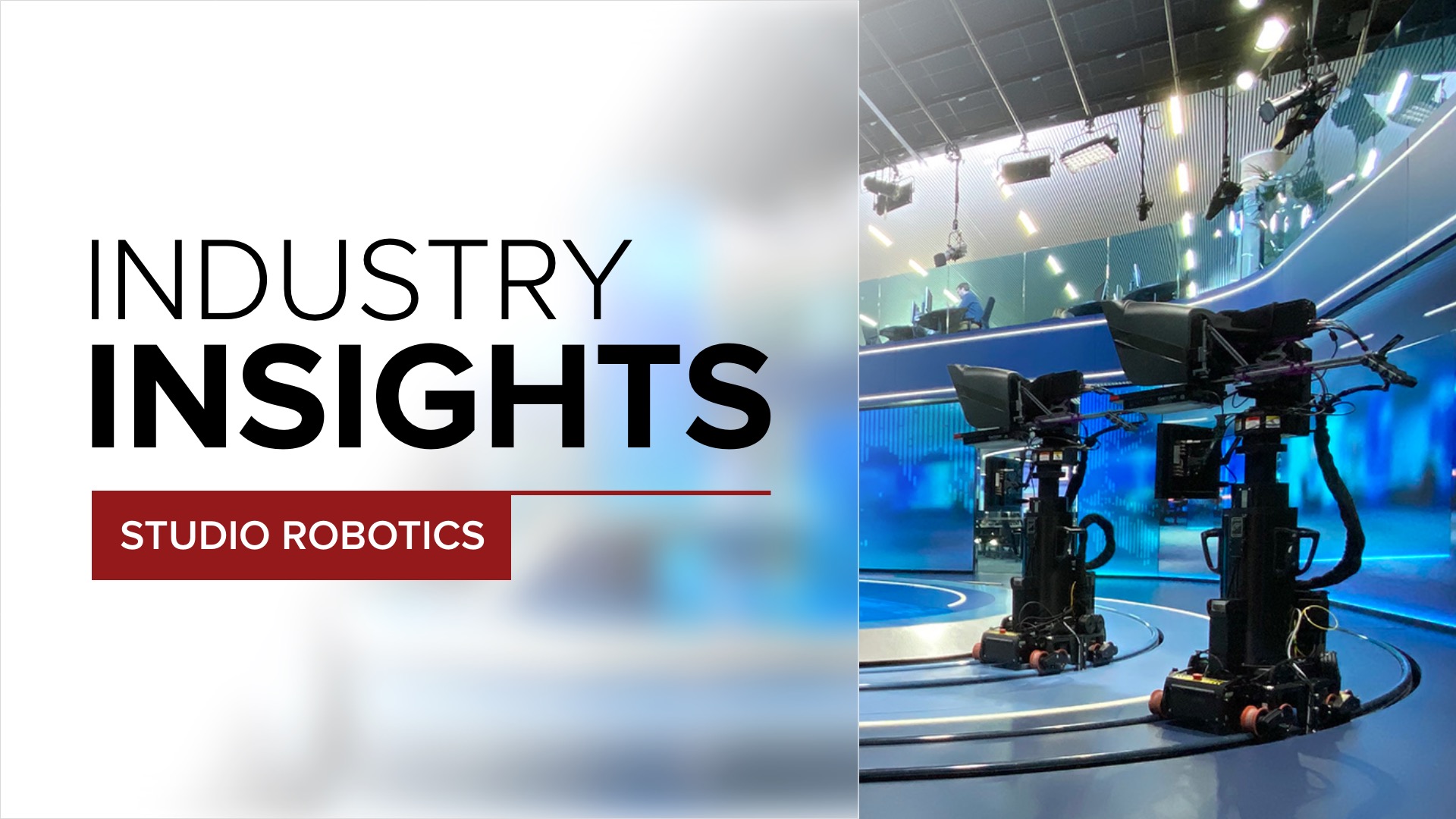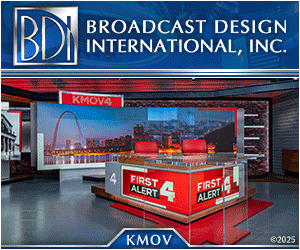Industry Insights: Latest advancements and trends in broadcast robotics

Subscribe to NCS for the latest news, project case studies and product announcements in broadcast technology, creative design and engineering delivered to your inbox.
In this edition of our Industry Insights roundtable series, we delve into the rapidly evolving landscape of broadcast studio robotics. Our expert panel unpacks the latest trends and technologies shaping storytelling inside the broadcast studio.
Key discussion points include the integration of artificial intelligence and computer vision, enhancing automation and real-time presenter tracking in studio environments. We also explore the role of IP networking in expanding remote broadcast capabilities and delve into the precision and accuracy required for live broadcasting. Innovations in control systems, camera movement, and integration with other studio equipment are highlighted, revealing the increasing sophistication and efficiency of modern broadcast robotics.
This roundtable provides a concise yet comprehensive overview of the current state and emerging trends in studio robotics, offering valuable insights for broadcast professionals navigating this technologically advanced landscape.
What key features are shaping the capabilities of the newest generation of broadcast robotics?
James Eddershaw, managing director, Shotoku: Robotics have always been about more than just cost saving. They require performance and reliability of a very high level, but ultimately efficiency savings are key. Consequently, automation compatibility and features like presenter tracking are therefore key areas of development in the latest robotics systems.
Paddy Taylor, head of broadcast, Mark Roberts Motion Control: Taking the example of our own product Polymotion Chat, AI or computer vision-powered robotics now automatically tracks and frames presenters and guests as they move around the studio. The advent of 5G is also providing the high-speed, low-latency connectivity that is essential for next-generation remote broadcast capture and acquisition.
Neil Gardner, senior product manager of robotics, Videndum Production Solutions: Broadcast robotics are advancing with higher degrees of automation, fueled by the capabilities of IP and the introduction of AI-driven technology. We are also repurposing features from other equipment such as Voice prompting to move away from the need for dedicated control hardware. This extends the reach of the system, both in terms of location and people, allowing remote locations to be set up with minimal resource and improving accessibility for less experienced operators.
Michael Cuomo, engineer, Telemetrics: Robotic camera control systems are being asked to drive more cameras/elevating pedestals/trolley systems and distribute more capabilities from a single control panel. This frees up the director or TD to focus on other parts of a production. Providing compatibility with IP networking is also important.
Karen Walker, VP of camera motion systems, Ross Video: A key challenge faced by our customers involves studio robotics navigating around structures in the studio, especially the increasingly popular moving LED screens and dynamic in-studio structures. As shows become more engaging and dynamic, the demand for seamless coordination with these elements intensifies. Our customers are actively seeking solutions with a focus on achieving cleaner floors, concealing cables effectively, and optimizing space by integrating ceiling rail systems.
How are robotics manufacturers ensuring precision camera movement and positioning for live broadcasting?
James Eddershaw: On-air quality camera movement requires core mechanical stability combined with powerful motion control algorithms. The accuracy and repeatability of studio positioning for fully robotic pedestals is especially important and that’s now being enhanced through the use of optical navigation systems providing always-referenced absolute position information (like a personal GPS system for the pedestal).
Paddy Taylor: MRMC’s heritage is in motion control, so the robotics we use are far more advanced than what most broadcasters use today. Our robotics are built for high performance, repeatable camera movement that gives frame accurate stable shots, as well as shots that are impossible to capture by hand.
Neil Gardner: Integrating an optical camera tracking system into a robot ensures consistently precise floor movement and has the added benefit of removing the need for repeat homing operations after the initial calibration. Where sensitive areas of a studio, such as high-value display equipment or structural features, need to be protected we add on the ability to position the robots within a studio map using a geo-fence.
Michael Cuomo: All of our robotics have a capability called “absolute positioning,” whereby there is no drift and no need for rehoming. They’re always millimeter accurate. I think that’s really important so that they don’t have to call up a shot and then the operator has to go over and adjust it. They know if they call up that shot and they take their eye off the camera, it’s going to get spot on, dead accurate every single time they call for it.
Karen Walker: Our robotics are designed to meet specific requirements and undergo rigorous testing to meet all requirements before shipment. This ensures our customers’ expectations are consistently met. The longevity of our products and the return on investment they offer contribute to customer satisfaction, fostering loyalty when they choose to upgrade their robotics.
What new directing workflows are emerging with the latest studio robotics control systems?
James Eddershaw: Broadcast robotics have been a common part of news studio equipment for many years, so workflows have already adapted to maximize the use of robotics. As we see greater and greater levels of automation being used, robotics are becoming even more widely integrated into the automation workflow. Automatic tracking of presenters and guests, with the ultimate goal of operator-less productions, is an emerging area of technology development which we expect to see more of.
Paddy Taylor: We are seeing a rise in the use of PTZs rather than manually controlled cameras. Through the advancements in PTZ camera technology, combined with MRMC’s PTZ enablement solutions, PTZ’s offer much more dynamic movement versus static cameras.
Neil Gardner: Presenter tracking technology is leading to a completely new workflow which moves away from using a grid of pre-set shots. Operation will focus more on telling the camera what framing is needed and allowing it to take over and maintain that based on the presenter’s position.
Michael Cuomo: The most useful workflow for a robotic camera control system is — when calling up multiple cameras — to have them move to a new location very quickly and smoothly. And, going back to the Path Planning, being able to move around set pieces has been really important because in the past maybe operators would have to have an extra couple of cameras so they don’t have to move the cameras quite as much. But now a lot of customers are using less cameras to be more efficient.
Karen Walker: Customers are increasingly automating show direction, requiring seamless integration of robotic cameras and control systems. We’ve noticed the exploration of voice control for task management, though it has not yet made its way into control rooms.
How can studios effectively integrate robotics with cameras, lenses and other systems?
James Eddershaw: Integration with lenses is a basic necessity for any robotic system. Today, lenses will almost always have full digital servo systems making integration with robotics very easy. Similarly, many have integrated VR/AR tracking data output, too for easy combination with the other robotic axes within a VR environment. Most camera systems now provide an API for remote operation of CCU functions enabling fully integrated IP-based camera and robotics control into a single control system.
Paddy Taylor: Through well-designed software that can act as an integrator of these waypoints. The systems should be able to enable the creative freedom of human movement and pair it with the precision and reliability of robotic camera systems.
Neil Gardner: Broadcast robotics have integrated with many systems for a long time, but as everything moves to a more sophisticated IP environment a robotic control system with modern enterprise-level architecture will integrate more simply into the wider corporate network. If a studio is moving towards broadcast robotics for the first time, selecting hybrid robotic/manual equipment allows users to move between manual and robotic operation as the production requires.
Michael Cuomo: Telemetrics camera control panels all include software features for painting cameras, adjusting/focusing lenses, smoothly panning multiple cameras simultaneously, if required. Our robotic systems provide power, control data and the connectivity, which is really important. So with cameras, that means providing power for the cameras. That also means providing control, whether that is over a remote port or over a network. Same thing with the lenses.
Karen Walker: Most studio robotics are agnostic of the cameras, lenses, and other equipment, such as the prompters being used. The key is to ensure that the payload is balanced, and we test all variations of payloads. It’s the inertia that affects the way the head moves, and without testing for worst-case scenarios, the precise movement will be affected and not meet customer expectations.
Subscribe to NCS for the latest news, project case studies and product announcements in broadcast technology, creative design and engineering delivered to your inbox.





tags
James Eddershaw, Karen Walker, Michael Cuomo, MRMC, Neil Gardner, Paddy Taylor, Ross Video, Shotoku Broadcast Systems, Telemetrics, Videndum Production Solutions, Vinten
categories
Broadcast Equipment, Camera Control & Camera Robotics, Camera Tracking, Cameras, Heroes, Industry Insights, Studio Technology, Voices